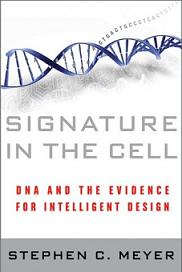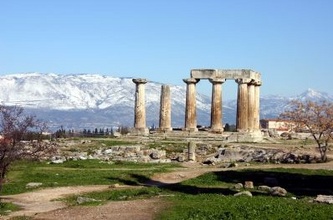
Stephen C. Meyer has published a (very long, but readable) book, Signature in the Cell: DNA and the Evidence for Intelligent Design, outlining his argument in favor of intelligent design. This book essentially argues that life is very complex, the origin of life is a puzzle, and the information content in DNA cannot be explained by natural means.
In the first several chapters of his book Meyer describes some of his personal history, the discovery of DNA and the double helix, and the broad brush workings of the cell in the process of using the DNA code to produce proteins. This is complex, involves many steps and uses proteins themselves produced using information in the DNA. Thus there is something of a Chicken and Egg problem:
The interdependence of proteins and nucleic acids raises many obvious “chicken and egg” dilemmas … The cell needs proteins to process and express the information in DNA inorder to build proteins. But the construction of DNA molecules (during the process of DNA replication) also requires proteins. So which came first, the chicken (nucleic acids) or the egg (proteins)?
… even the simplest living things operate as complex systems of interdependent parts. Yet how this feature of life could have arisen is, as Jaques Monod put it, “exceedingly difficult to imagine.” (p. 134)
This will be part of the core of Meyer’s argument for intelligent design – but more groundwork is necessary. He goes on to discuss some of the history of science and the role of design hypotheses; the process of inference to best explanation; the need to look at causal existence and causal adequacy when considering historical problems; and then takes a foray into probability and pattern recognition. All of this is preparatory to his main arguments and conclusions.
I found these chapters interesting – and in places educational. I have never much considered the factors at work in the evaluation of historical puzzles – scientific or otherwise.
The basic questions are simple …
How do scholars (scientists or historians) reason and make inferences about the past? Are these inferences testable? If so, how?
and – in a detour from Meyer’s book and argument:
Why believe that the resurrection is true? How is this conclusion reached or justified?
The second question seems a bit of a leap, but it is the thought that occurred to me as I was reading Ch. 7 Of Clues to Causes in Meyer’s book. One of the questions that is often asked in the discussion of science, faith, and scripture is roughly this – how can we deny the historicity of Noah and the Flood and still defend the resurrection as a historically factual event. If everything hinges on scripture isn’t questioning the story of Noah the first step on a path that leads to rejection of both? We cannot, many say, pick and choose.
But back to Meyer and Signature in the Cell … In Ch. 7 Meyer outlines a general approach to the consideration of historical questions. In particular he considers the ideas of inference to best explanation, causal adequacy and causal existence beginning with the ideas developed by Peter Lipton in his book Inference to the Best Explanation (International Library of Philosophy).
According to Lipton, “beginning with the evidence available to us” we generally “infer what would, if true, best explain that evidence.” (p. 156)
He showed that scientists often evaluate competing inferences or hypothesis by comparing their explaining power. That is, assessments of an inference’s explaining power determines how much stock we place in it. (p. 156)
A good (or best) explanation cites an event and makes a “causal difference” in the outcome. (p. 157)
An explanation must have causal existence and causal adequacy. That is – it must be plausible or demonstrable that the cause existed and that it is capable of giving rise to the observed result. But there is another criterion as well – a best explanation must account for all of the evidence. There must be a consistent, coherent story.
This method of reasoning, testing ideas, is not limited to the historical sciences – but is used in many areas of scholarship and life. Meyer suggests that it is not used in experimental sciences – chemistry and physics, but I think it is used more widely in these sciences than he realizes. Meyer does see broad application though:
Even so, historical scientists are not the only scientists to use it. … And many scientists – theoretical physicists, biochemists, psychologists, astronomers, pathologists, medical diagnosticians – as well as historians, detectives, and thinking people everywhere use this method of reasoning every day to make sense of their experiences. (170)
Meyer is going to use this discussion as part of his case for intelligent design as the best explanation for the information content of the cell. But before considering more of his argument I am going to continue on the detour I began above.
Why are the historicity of Noah’s Flood and of the Resurrection distinct separable problems?
I consider the story of Noah and the Flood to be a story that conveys important theological truths, that may have roots in a real, limited, local event, but is not literal history as told in Genesis. On the other hand I consider the resurrection to be a historically factual event. Yet many times these two examples are made to hang together. Why the difference in conclusion? Doesn’t this mean that we can just pick and choose and ultimately everything falls?
It really isn’t that simple. I don’t believe the Christian story on the strength of scripture alone. I don’t think that many of us take scripture alone as the source and foundation for our faith (not even Calvin or Luther, as I read their writings). Rather we take scripture, tradition, reason, and experience – and perhaps more. Scripture is important – but it does not stand alone. Scot’s book The Blue Parakeet has important insights here. Our experience and understanding is a total package.
So Back to Flood and Resurrection.
First, the flood … many things to consider here: the story in scripture, the recognition that God can perform miracles, the fact that scripture does convey truth in story form at times, the diversity and dispersion of animals (far too many for an ark), the size of the ark, the prevalence of the story in ANE mythology, the nature of the text as a compilation of sources, the lack of any geological evidence for a global flood, the inconsistency of a bottleneck in human population – reduced to only a handful a mere 5000 years ago or so with all of the available data. I could continue – but the case is overwhelming. The only reason to take the view of a literal global flood – or even a local flood that wiped out human population – is a presupposition about the nature of scripture … not a presupposition on the authority of scripture, but a presupposition about the nature of the authority of scripture.
Second, the resurrection considering all of the evidence: the story in scripture, the recognition that God can perform miracles, the growth of the church, … the evidence all hangs together. The only reason to reject the resurrection out of hand is a conviction that dead people don’t rise – in essence that God does not exist. NT Wright in The Resurrection of the Son of God lays the case out in great detail (Surprised by Hope has a shorter less academic version of the argument). His lecture “Can a Scientist Believe in the Resurrection” found here or here presents an overview (another related lecture here).
I don’t see how the conclusion on one of these questions of historicity has any influence on the other. Neither conclusion reached above rejects scripture – rather both accept scripture as inspired by God and profitable for teaching, for reproof, for correction, for training in righteousness; to equip for every good work; able to give the wisdom that leads to salvation through faith which is in Christ Jesus.
Now – a conclusion that the resurrection is not historical would have serious ramifications for orthodox Christian faith, a similar conclusion about Noah’s Flood has no significant consequence for orthodox Christian faith. These factors also play into my thinking at times (say if we consider the question of the virgin birth for example) … but the overall search is for a consistent coherent picture.
What do you think? How do you reason and make inferences about the past? How do you test these inferences? How does this apply to the way we read scripture?
If you wish to contact me, you may do so at rjs4mail[at]att.net

